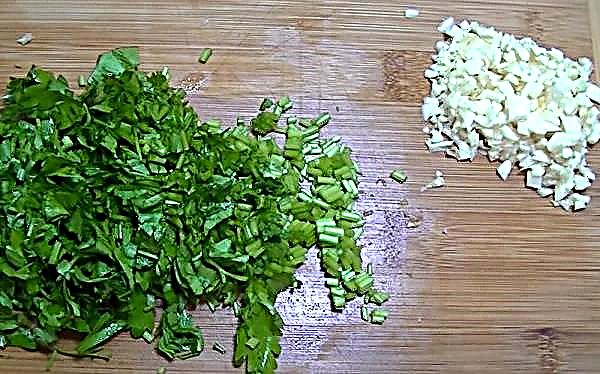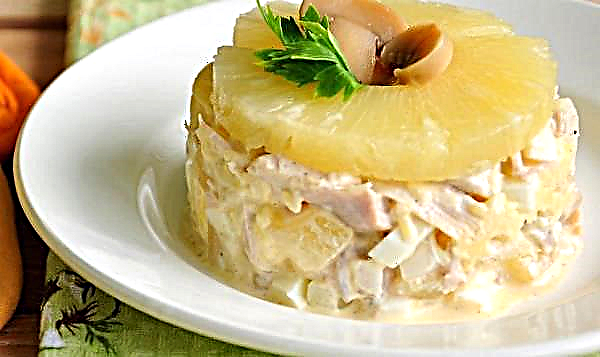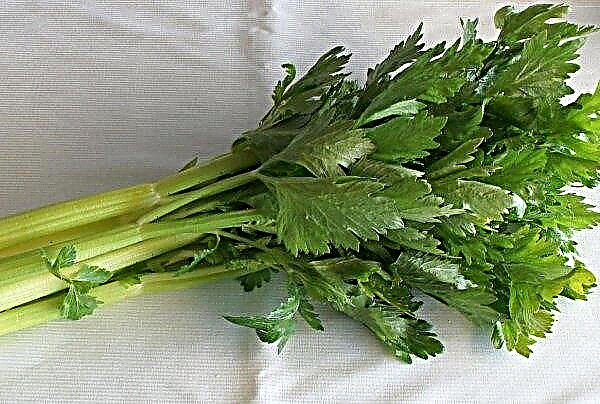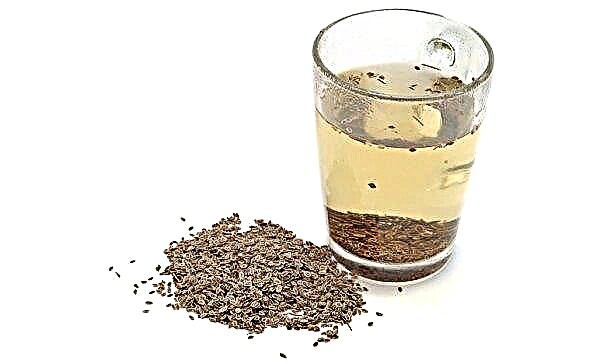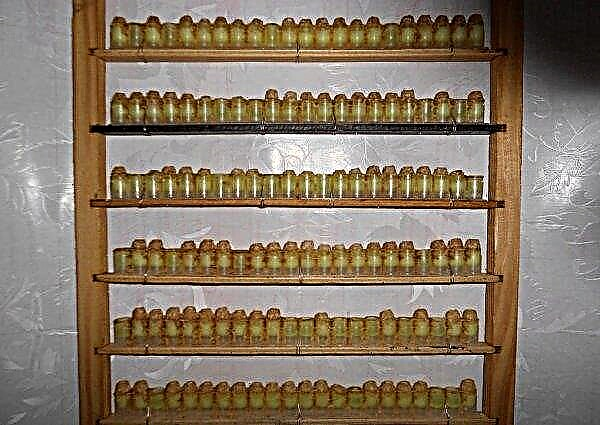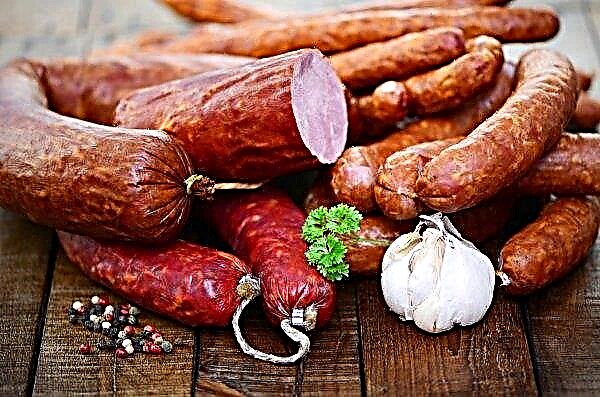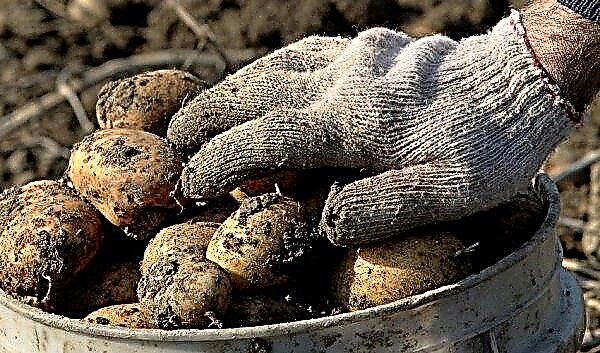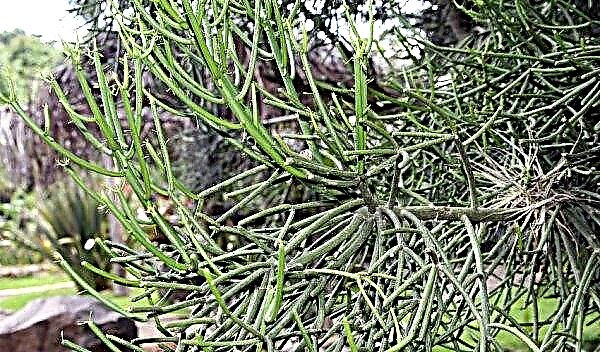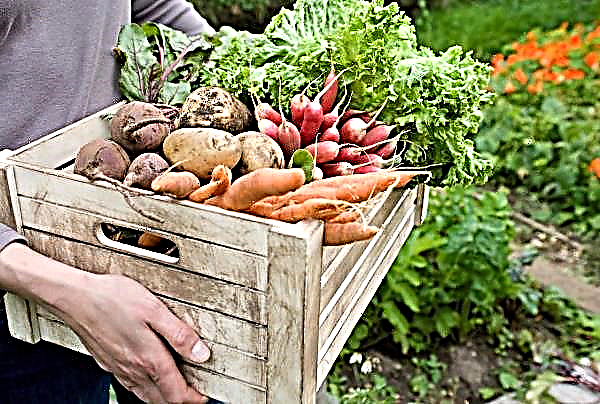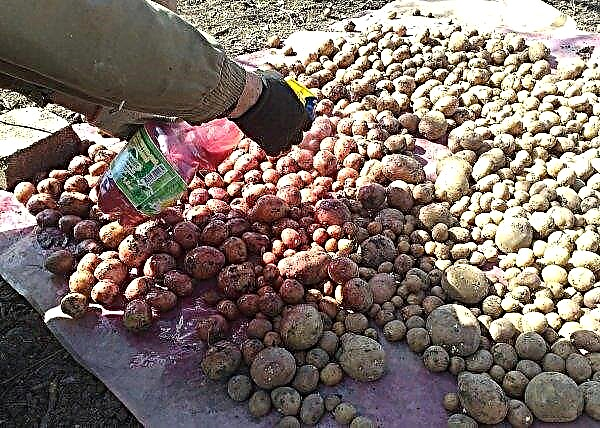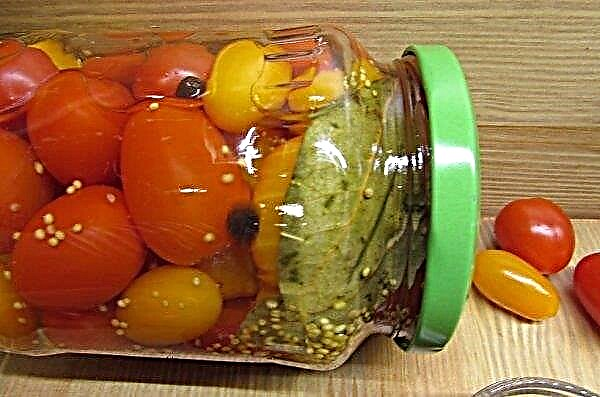Among tomatoes, a special place is occupied by early varieties. At least one such variety is grown by every gardener. Tomato Lyubasha F1 is popular, as the first crop from the bushes ripens in June. Read about the features of cultivation and the advantages of the variety in this review.
Grade description
Variety Lyubasha F1 - super early, with the ripening of the first fruits on 65–75 days. Harvest ripening time is June. In one internode of Lyubasha, 2 flower brushes are formed. Each brush gives a full crop - 15–20 kg of tomatoes per 1 sq. Km. m square.
Did you know? The degree of sweetness of tomatoes is measured on the Brix scale. The taste of individual specimens can be measured by the color of the peel. Light tomatoes are generally sweeter. And the dark – more tart.
The main characteristics of the Lyubasha variety:
- determinant, with a height of about 1 m;
- ultra-early, with the ripening of the first fruits on 65–75 days;
- type - universal: used in fresh and canned form;
- can be grown in greenhouses and open ground;
- the bush is compact, formed in 2–4 main stems, which increases productivity;
- care for the bush involves tying and pinching;
- stalks are strong, with a large number of leaves of dark green color;
- 5-6 brushes are formed on 1 stalk;
- productivity of 1 bush - 4–5 kg;
- fruits - roundish, slightly flattened, bright red with a dense skin, resistant to cracking;
- fruit weight - 200–100 g, the first tomatoes are larger than the subsequent ones;
- taste is sweetish;
- the flesh is juicy;
- resistant to solanaceous diseases: fusarium, rot, late blight, alternariosis.

Advantages and disadvantages
- Among the advantages of the Lyubasha F1 variety, the following are noted:
- ultra-early ripening;
- good yield;
- excellent taste;
- universality: grows well in a greenhouse and in open ground;
- disease resistance.
- The disadvantages of the variety:
- poor tolerance to low temperatures;
- the variety needs care: top dressing, garters.
Self-growing seedlings
Early varieties are grown through seedlings. This allows you to get a crop in early June. The age of seedlings at the time of planting in the soil should be 50 days.
Did you know? Tomatoes have been used for food since 500 BC. The Aztec civilization called the found plant "tomato", which meant "big berry."
To plant seeds for seedlings, you will need:
- containers for planting seeds and for diving young seedlings;
- seed packaging;
- soil for planting;
- rack for the installation of containers with seedlings;
- fluorescent lamps;
- fertilizers;
- antibacterial drugs, growth stimulants.
Before planting, seeds are treated for disease. After emergence - provide the correct light mode, watering and top dressing.
Sowing time
The time for planting seeds depends on when the soil is ready for planting seedlings. The optimal time for landing is March. At this time, daylight hours are at least 12 hours, which is good for plant development. By the time of transplanting into the soil, the seedlings should not outgrow, otherwise it is poorly received and weakly fruiting. Given the beginning of fruiting, you need to plant Lyubasha bushes for 45-50 days. Soil frost in most regions continues until May. Therefore, the seed planting period is March 20–25.
Did you know? The soil consists of 45% minerals, 25% water, 25% air and 5% organic matter. Sand, clay and silt together create different types of soils.
The soil
Soil components are sand, silt and clay. Their ratio and create a variety of soils. The root system of a tomato consists of a central stem and many small roots. Therefore, the bushes need loose soil. If the soil is dense, clayy in the area, you can “fluff” it using sand, peat, sawdust. Soil acidity should be neutral or alkaline - 6.5 pH and lower. Acidity can be measured with special test strips.
To do this, mix several tablespoons of soil with a small amount of distilled water in a container and lower the strip there. Green marks indicate neutral ground. Acidic soil is deoxidized by adding chalk or dolomite flour. For the same purpose, fertilizers containing ammonium sulfate are used. The event is carried out in the preparation of beds for planting seedlings. For the cultivation of seeds, modern technologies offer peat tablets - compressed peat, which swells under the influence of moisture and becomes a cylinder with seed sprouted in it. You can take ordinary soil from the beds, calcine it in the oven and use it for planting seedlings. Annealing disinfects the earth and destroys wintering pests. Even if a mixture is purchased from a store for seedlings, it must be treated with a 3% solution of potassium permanganate to destroy spores of putrefactive bacteria.
For the cultivation of seeds, modern technologies offer peat tablets - compressed peat, which swells under the influence of moisture and becomes a cylinder with seed sprouted in it. You can take ordinary soil from the beds, calcine it in the oven and use it for planting seedlings. Annealing disinfects the earth and destroys wintering pests. Even if a mixture is purchased from a store for seedlings, it must be treated with a 3% solution of potassium permanganate to destroy spores of putrefactive bacteria.
Capacity for growing
Seedlings are grown in containers with different texture and size. A common type of container is a box for seedlings. Such are available in most gardeners. They are easy to make from improvised building materials: wood, plastic. Now in stores cassettes are sold, which consist of separate containers for growing seedlings. They are comfortable. But you should not buy large cassettes, for 50-100 plants. They are inconvenient for daily care of seedlings, and when planting plants in the ground, individual plants may be damaged.
Peat glasses are used to dive seedlings. Such a glass, when transplanted into the ground, is planted together with a bush and serves as an additional fertilizer for the roots. Peat tablets are actively used for planting seeds. This soil is ideally suited for the development of the root system: it is nutritious, it passes water and air well. An overgrown plant is planted with the tablet, so you will not damage the roots when transplanted.
Seed preparation
Spores of pathogenic fungi are not visible to the naked eye. Therefore, all seeds are treated in warm water (+50 ° C) for 20 minutes. Hot water is detrimental to fungal spores. Warming seeds under a table lamp increases the percentage of germination, and also improves the formation of ovaries. Modern agricultural technology for growing tomatoes includes seed treatment with antibacterial drugs. This method is considered more effective than treatment with alternative methods. Among the popular ones is seed treatment with Fitosporin. The active ingredient is the soil bacterium Bacillus subtilis. Developing, the bacterium inhibits the development of pathogenic microflora in the soil, which affects the health of plants and their growth. Seed treatment with a growth stimulator is also practiced. The drug "Zircon" is both a fertilizer, and a growth stimulator, and an immunomodulator. Seeds treated with Zircon are resistant to disease, hatch quickly and grow better. By strengthening the root system, such drugs improve the development of seedlings, ovaries and accelerate growth. Stimulants are used in strict accordance with the instructions for the drugs.
The active ingredient is the soil bacterium Bacillus subtilis. Developing, the bacterium inhibits the development of pathogenic microflora in the soil, which affects the health of plants and their growth. Seed treatment with a growth stimulator is also practiced. The drug "Zircon" is both a fertilizer, and a growth stimulator, and an immunomodulator. Seeds treated with Zircon are resistant to disease, hatch quickly and grow better. By strengthening the root system, such drugs improve the development of seedlings, ovaries and accelerate growth. Stimulants are used in strict accordance with the instructions for the drugs.
Sowing seeds
Preparation for sowing seeds consists of processing containers with disinfectants. If this is a new container, just wash it with soap. If the boxes were used in the previous season, antibacterial treatment will not hurt.
Important! Seeds for seedlings for the greenhouse are recommended to be sown on March 15, and for open ground - April 5.
Fill the container with 2/3 soil. When planting in boxes, place seeds with a distance of at least 2-3 cm between individual plants and between rows. Press the seeds with your finger to the soil and add another 0.5 cm of soil. Moisten the earth with a spray gun.
When planting seeds in peat tablets, wet the tablets with water and place them in a plastic container. When the tablet increases in size by 4–5 times, place 1-2 seeds in its center and squeeze them. Cover containers with seedlings with a film to create a greenhouse effect. After 7-10 days, seedlings should hatch. As soon as this happens, open the film for 2-3 hours a day, and after a few days remove it.
Seedling Care
Seedling care includes:
- regular watering;
- fertilizer application;
- dive;
- hardening.
Important! Tomatoes are planted to a depth of 10–12 cm. About 0.7 l of water is poured under each bush.
At the same time, seedlings are fed. If seedlings were planted in peat tablets or very nutritious soil, then top dressing can be omitted. Top dressing should include nitrogen, potassium and phosphorus. For balanced soils, fertilizers are used in equal shares. If the soil lacks certain substances, you can feed tomatoes with one of the fertilizers. You can always determine the lack of nutrients by the state of the leaves. The second feeding is carried out 2 weeks after the previous one. In this case, the same fertilizer is used as at the beginning. Fertilizers can be synthetic and organic. Organic fertilizers include mullein or bird droppings. For feeding, they are diluted with water in a ratio of 1:12 (for litter) and 1: 7 (for mullein). So that the seedlings do not stretch, the air temperature should be +16 ... + 18 ° C. Luminescent lamps are placed above the seedlings, thereby increasing the duration of daylight hours to 14-18 hours.
Fertilizers can be synthetic and organic. Organic fertilizers include mullein or bird droppings. For feeding, they are diluted with water in a ratio of 1:12 (for litter) and 1: 7 (for mullein). So that the seedlings do not stretch, the air temperature should be +16 ... + 18 ° C. Luminescent lamps are placed above the seedlings, thereby increasing the duration of daylight hours to 14-18 hours.
Seedling hardening
Seedlings indoors and in the ground after planting are in different climatic conditions. So, in the room there is no difference in day and night temperatures, humidity fluctuations occur less frequently, and its amplitude is much smaller. In order for tomatoes to adapt in the open ground, they begin to harden. For this, plants are daily taken out into the air or left by an open window.
Important! Lack of fertilizer can be seen by the condition of the leaves. If they turn yellow and fall off, the plant lacks nitrogen. If the leaves turn purple - phosphorus deficiency. And pale yellow with green veins report a lack of iron.
They begin hardening 2 weeks before planting. Daily time of plants in the air is increased by 15-60 minutes. In rain or cool weather (less than +14 ° C), tomatoes can not stand. Hardened healthy seedlings are distinguished by a thick trunk, well-developed 8–10 leaves and developed roots. Planted in a permanent place, seedlings are more stable and less sick.
Planting seedlings in a permanent place
It is advisable to plant Lyubasha in open ground 45–50 days after the appearance of sprouts. In the process of growth, bushes reach a height of 1 m, so they need to be planted at a distance of 0.5-0.6 m between individual plants. Tomatoes are planted in rows no matter where they grow. This planting makes it easier to care for plants: weeding, watering, fertilizing and harvesting.
Before planting, it is necessary to prepare the soil. Deoxidation of acidic soil should occur 2-3 weeks before transplanting seedlings. Organic fertilizers are also added to the soil 1 week before planting. The introduction of dry components is carried out to a depth of 10-15 cm, carefully digging the soil. Landing is carried out in trenches or holes. The size of the hole should be larger than the root system of the seedling along with the soil in which it grew. This is done in order to leave loose soil around the bush for the development of tomato roots. The elongated seedlings can be deepened. This will reduce the trunk and strengthen the roots, as the tomato can take root from any part of the trunk.
Landing is carried out in trenches or holes. The size of the hole should be larger than the root system of the seedling along with the soil in which it grew. This is done in order to leave loose soil around the bush for the development of tomato roots. The elongated seedlings can be deepened. This will reduce the trunk and strengthen the roots, as the tomato can take root from any part of the trunk.
A frost can ruin a tomato plantation Lyubasha. Plant plants in a permanent place in the ground, provided that the air temperature is at least +18 ... + 21 ° C. If the night temperature drops below, the tomatoes are planted under a film cover, which, after rooting, seedlings are removed.
Outdoor Care
In the open field, plants are watered weekly, fertilizers are periodically applied, weeds are tied and weed, stepsons are planted, they are fighting pests, and the soil is loosened. Proper care promotes stable plant growth and increases productivity.
Important! The first hilling is necessary 2 weeks after the seedlings are planted in a permanent place. The second - during the appearance of stepchildren.
Watering
The optimal watering for tomatoes is drip irrigation. To create such a system, pipes are laid for supplying water with droppers and dispensers. Drip irrigation is comfortable for plants. Moisture is evenly distributed over the root zone to a depth of 8-10 cm. Using drip irrigation, it is also convenient to apply root fertilizers.
The rules of ordinary watering:
- Water the tomatoes as the soil dries, but at least 1 time per week.
- Water should pour slowly, as the plant selects nutrients with microroots, which are easily destroyed by intensive irrigation.
- Do not soak soil deeper than 10 cm - micronutrients and fertilizers will be washed to the depth to which the earth is watered.
- Do not splash water on the leaves. Humidity increases the risk of infection with late blight and other diseases.
- Do not water the bushes at night. Lower temperatures and high humidity contribute to disease.

Fertilizer application
Tomato Lyubasha needs to follow the fertilizer schedule. For root top dressing, granular fertilizers are considered the best. They release trace elements gradually, thereby prolonging the duration of the action of drugs on plants.
For feeding use:
- superphosphate - 50 g;
- potassium - 30 g;
- ammonium nitrate - 15 g.
All components are dissolved in water (10 l) and introduced into the root zone of each bush 1 l. For the first time after planting plants at a permanent place, fertilizers are applied after 2 weeks. Further feeding is continued every 2 weeks. In the fruiting phase, the last top dressing is carried out. Fertilizers are also applied, if the state of the tomatoes shows that they lack micronutrients.
Stepson
Pasynkovka - a procedure for removing lateral shoots. For tomato Lyubasha stepsoning is necessary. Pinch the side shoot at a height of 0.5 cm from the growth point. If these shoots are not removed, the plant spends energy and nutrients on their development, reducing the amount of fruiting.
Soil care
The soil is cultivated so that nutrients and oxygen enter the roots for development.
Types of soil care:
- weed weeding;
- aeration (loosening);
- mulching;
- hilling.
These measures do not affect the yield, but help the tomatoes develop. Weeding is performed the day after watering, when the earth dries. In small areas, weeds are weeded out using a garden hoe. At the same time, the soil is loosened in order to increase the access of oxygen to the roots of tomatoes.
Mulching - covering with a covering material of a zone free from plants. The soil can be covered with organic materials: sawdust, straw, grass or inorganic ones - spunbond, agrofibre, cardboard. Mulching prevents soil compaction, inhibits weed growth, nourishes the soil and protects the roots from weather changes and pests. The recommended layer of mulch is 7 cm.
Hilling - creating around the trunk of a small hill of soil. Tomatoes are spudded to enhance the development of the root system. Good root development improves the absorption of trace elements by tomato.
Tying bushes
Variety Lyubasha bears fruit abundantly. The bush is formed in 2–4 trunks, on each of which 5–7 flower brushes are formed.The yield of 1 bush is about 5 kg. Keeping that weight is difficult. Therefore, gardeners tie up branches to reduce the load on the trunk and hands. Lyubasha’s height is 1 m. The variety can be tied to a trellis (vertical or horizontal) or to pegs. Tie up the plant as it grows. For the entire growing season - 2-3 times. To do this, use small flaps of tissue that will gently hold the branches without pinching them.
Harvesting and storage
Tomatoes ripen massively in July. The first crop is removed for eating. Mass gathering of fruits is carried out in order to harvest ripe tomatoes for the winter or because of the threat of frost and prolonged rain. Signs of late blight on individual tomatoes are also a reason for harvesting. With the simultaneous harvest of tomatoes, the unripe part of the crop can ripen within 10-15 days at room temperature. In addition, there are recipes for harvesting unripe green tomatoes for the winter, which are worth using if there are a lot of them. Harvested tomatoes can be stored in crates in a dry, ventilated room for up to 2 months. Do not store deformed or damaged fruits. Spores of rot will spread to other tomatoes, and you will lose them. Harvest is stored in dry boxes without stalks. The fruits are laid in 2-3 layers, leaving enough space between the individual specimens, since in a torn form they continue to grow and increase in size. The air temperature in the storage should be within +3 ... + 5 ° С.
Harvested tomatoes can be stored in crates in a dry, ventilated room for up to 2 months. Do not store deformed or damaged fruits. Spores of rot will spread to other tomatoes, and you will lose them. Harvest is stored in dry boxes without stalks. The fruits are laid in 2-3 layers, leaving enough space between the individual specimens, since in a torn form they continue to grow and increase in size. The air temperature in the storage should be within +3 ... + 5 ° С.
To keep the crop in the basement until January, dry straw is laid at the bottom of the box. Individual fruits are wrapped in paper or straw. The box is covered with a lid so that there is air access to the fruit. Store at a temperature slightly below 0 ° C.

